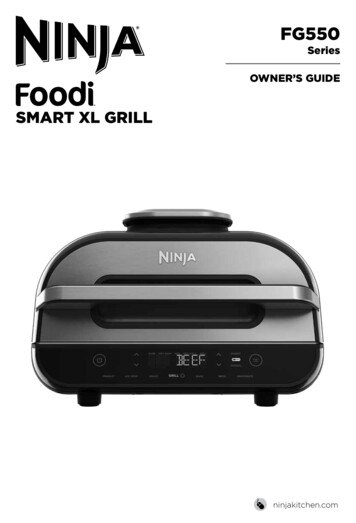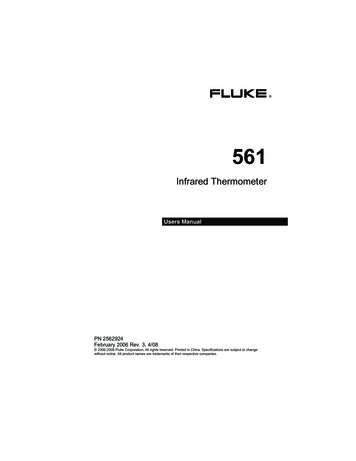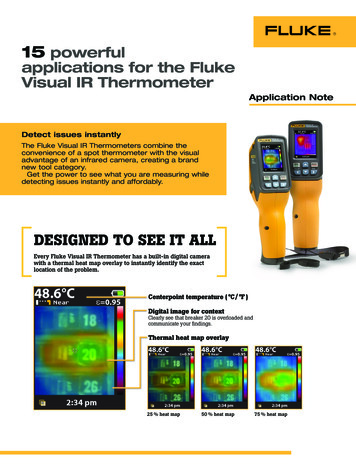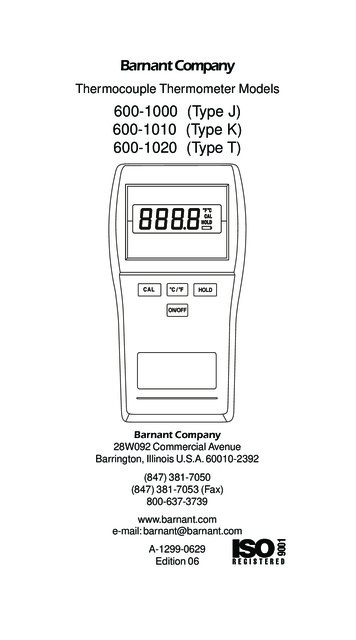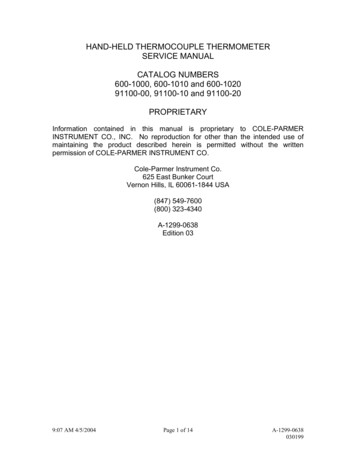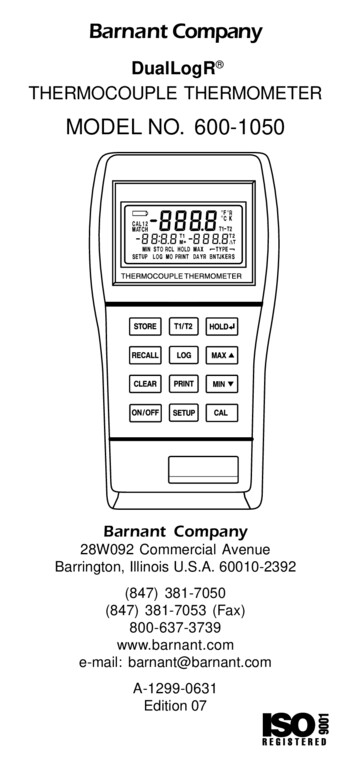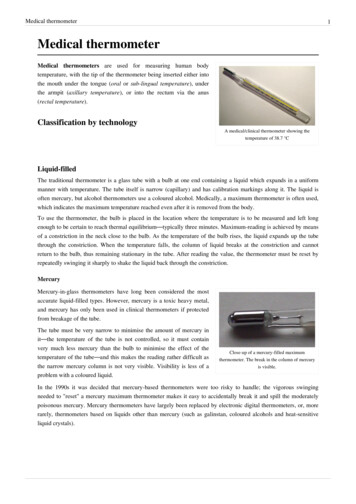
Transcription
Medical thermometer1Medical thermometerMedical thermometers are used for measuring human bodytemperature, with the tip of the thermometer being inserted either intothe mouth under the tongue (oral or sub-lingual temperature), underthe armpit (axillary temperature), or into the rectum via the anus(rectal temperature).Classification by technologyA medical/clinical thermometer showing thetemperature of 38.7 CLiquid-filledThe traditional thermometer is a glass tube with a bulb at one end containing a liquid which expands in a uniformmanner with temperature. The tube itself is narrow (capillary) and has calibration markings along it. The liquid isoften mercury, but alcohol thermometers use a coloured alcohol. Medically, a maximum thermometer is often used,which indicates the maximum temperature reached even after it is removed from the body.To use the thermometer, the bulb is placed in the location where the temperature is to be measured and left longenough to be certain to reach thermal equilibrium—typically three minutes. Maximum-reading is achieved by meansof a constriction in the neck close to the bulb. As the temperature of the bulb rises, the liquid expands up the tubethrough the constriction. When the temperature falls, the column of liquid breaks at the constriction and cannotreturn to the bulb, thus remaining stationary in the tube. After reading the value, the thermometer must be reset byrepeatedly swinging it sharply to shake the liquid back through the constriction.MercuryMercury-in-glass thermometers have long been considered the mostaccurate liquid-filled types. However, mercury is a toxic heavy metal,and mercury has only been used in clinical thermometers if protectedfrom breakage of the tube.The tube must be very narrow to minimise the amount of mercury init—the temperature of the tube is not controlled, so it must containvery much less mercury than the bulb to minimise the effect of thetemperature of the tube—and this makes the reading rather difficult asthe narrow mercury column is not very visible. Visibility is less of aproblem with a coloured liquid.Close-up of a mercury-filled maximumthermometer. The break in the column of mercuryis visible.In the 1990s it was decided that mercury-based thermometers were too risky to handle; the vigorous swingingneeded to "reset" a mercury maximum thermometer makes it easy to accidentally break it and spill the moderatelypoisonous mercury. Mercury thermometers have largely been replaced by electronic digital thermometers, or, morerarely, thermometers based on liquids other than mercury (such as galinstan, coloured alcohols and heat-sensitiveliquid crystals).
Medical thermometerElectronicSince compact and inexpensive methods of measuring and displayingtemperature became available, electronic thermometers (often calleddigital, because they display numeric values) have been used. Manydisplay readings to great precision (0.1 C or 0.2 F, sometimes halfthat), but this should not be taken as a guarantee of accuracy: specifiedaccuracy must be checked in documentation and maintained byElectronic clinical thermometersperiodical recalibration. A typical inexpensive electronic earthermometer for home use has a displayed resolution of 0.1 C, but a stated accuracy within 0.2 C when new.[1]ContactElectronic thermometers may work by contact (the electronic sensor is placed in the location where temperature is tobe measured, and left long enough to reach equilibrium). They typically reach equilibrium faster than mercurythermometers; the thermometer may beep when equilibrium has been reached, or the time may be specified in themanufacturer's documentation.RemoteOther electronic thermometers work by remote sensing: an infrared sensor responds to the radiation spectrumemitted from the location. Although they are not in direct contact with the area being measured, they may touch partof the body (a thermometer which senses the temperature of the eardrum without touching it is inserted into the earcanal). To eliminate the risk of patient cross-infection, disposable probe covers and single-use clinical thermometersof all types are used in clinics and hospitals.Basal thermometerA basal thermometer is a thermometer used to take the basal (base) body temperature, the temperature upon waking.Basal body temperature is much less affected than daytime temperature by environmental factors such as exerciseand food intake. This allows small changes in body temperature to be detected, such as those caused by ovulation[2]or changes in thyroid function.Glass fever thermometers typically have markings every 0.1 C or 0.2 F. Basal temperature is stable enough torequire accuracy of at least 0.05 C or 0.1 F, so special glass basal thermometers are distinct from glass feverthermometers. Digital thermometers which have sufficient resolution (0.05 C or 0.1 F is sufficient) may be suitablefor monitoring basal body temperatures; the specification should be checked to ensure absolute accuracy, andthermometers (like most digital instruments) should be calibrated at specified intervals. If only the variation of basaltemperature is required, absolute accuracy is not so important so long as the readings do not have large variability(e.g., if real temperature varies from 37.00 C to 37.28 C, a thermometer which inaccurately but consistently reads achange from 37.17 C to 37.45 C will indicate the magnitude of the change). Some digital thermometers aremarketed as "basal thermometers" and have extra features such as a larger display, expanded memory functions, orbeeping to confirm the thermometer is placed properly.Classification by locationThe temperature can be measured in various locations on the body which maintain a fairly stable temperature(mainly sub-lingual, axillary, rectal, vaginal, forehead, or temporal artery). The normal temperature varies slightlywith the location; an oral reading of 37 C does not correspond to rectal, temporal, etc. readings of the same value.When a temperature is quoted the location should also be specified. If a temperature is stated without qualification(e.g., typical body temperature) it is usually assumed to be sub-lingual. The differences between core temperatureand measurements at different locations, known as clinical bias, is discussed in the article on normal human body2
Medical thermometertemperature. Measurements are subject to both site-dependent clinical bias and variability between a series ofmeasurements (standard deviations of the differences). For example, one study found that the clinical bias of rectaltemperatures was greater than for ear temperature measured by a selection of thermometers under test, but variabilitywas less.[3]OralOral temperature may only be taken from a patient who is capable of holding the thermometer securely under thetongue, which generally excludes small children or people who are unconscious or overcome by coughing,weakness, or vomiting. (This is less of a problem with fast-reacting digital thermometers, but was certainly an issuewith mercury thermometers, which took several minutes to stabilise their reading.) If the patient has drunk a hot orcold liquid beforehand time must be allowed for the mouth temperature to return to its normal value.[4]The typical range of a sub-lingual thermometer for use in humans is from about 35 C to 42 C or 90 F to 110 F.RectalRectal temperature-taking, especially if performed by a person other than the patient, should be facilitated with theuse of lubricant (such as petroleum jelly (now discouraged) or a water-based personal lubricant). Although rectaltemperature is the most accurate, this method may be considered unpleasant, or embarrassing in some countries orcultures, especially if used on patients older than young children; also, if not taken the correct way, rectaltemperature-taking can be uncomfortable and in some cases painful for the patient. Rectal temperature-taking isconsidered the method of choice for infants.[5]EarOther kinds of medical thermometers exist, such as the tympanic thermometer that measures the temperature of thetympanum by infrared measurement, The thermometer has a projection (protected by a one-time hygienic sheath)which contains the infrared probe; the projection is gently placed in the ear canal and a button pressed; thetemperature is read and displayed within about a second. These thermometers are used both in the home (models areavailable for prices starting at around US20) and in medical facilities.Temporal arteryA newer development is the Temporal artery thermometer, which uses the infrared principle to accurately report apatient's temperature, with comparable accuracy to rectal thermometry.ForeheadThe band thermometer is applied to the patient's brow. It is typically a band coated with differenttemperature-sensitive markings using liquid-crystal or similar technology; at a given temperature the markings(numerals indicating the temperature) in one region are at the right temperature to become visible. This type gives anindication of fever, but is not considered accurate.3
Medical thermometerReferences[1] Specification of typical inexpensive electronic ear thermometer (http:/ / www. landisgyr. biz/ pdfs/ EarT. pdf)[2] Weschler, Toni (2002). Taking Charge of Your Fertility (Revised ed.). New York: HarperCollins. ISBN 0-06-093764-5.[3] pubmed.gov: Comparison of infrared ear thermometer derived and equilibrated rectal temperatures in estimating pulmonary arterytemperatures (http:/ / www. ncbi. nlm. nih. gov/ pubmed/ 8797622) CONCLUSIONS: The three infrared ear thermometers studied provided acloser estimate of core body temperature than equilibrated rectal temperature. Clinical bias was greatest in febrile vs. afebrile intensive careunit patients[4] Newman, Bruce H.; Martin, CA (2001). "The effect of hot beverages, cold beverages, and chewing gum on oral temperature". Transfusion 41(10): 1241. doi:10.1046/j.1537-2995.2001.41101241.x. PMID 11606822.[5] Fundamentals of Nursing by Barbara Kozier et al., 7th edition, p. 4954
Article Sources and ContributorsArticle Sources and ContributorsMedical thermometer Source: http://en.wikipedia.org/w/index.php?oldid 443080171 Contributors: Abrech, Acolyte of Discord, Acroterion, Anaxial, Anna Lincoln, Arcadian, Asphaltbuffet,Avidmosh, Avrilgreen, Bkell, Bobo192, CT Cooper, Cflm001, Chemical Engineer, Closedmouth, Cometstyles, Cst17, DMacks, Ddxc, Dekimasu, Dicklyon, Dinferno, Discospinster, Eneville,Enviroboy, Ferengi, Fireball80000, Florian Prischl, George100, Gogo Dodo, Groyolo, Icairns, JoeSmack, JohnCD, Jossi, Jovianeye, Keyesc, Kingdon, LeaveSleaves, Lframe69, Lumos3, Lyrl,Maziotis, Mhaitham.shammaa, NewEnglandYankee, Ngthithuvan9999, Northumbrian, Ohnoitsjamie, Oxymoron83, Paiamshadi, PeregrineAY, Pol098, Professor Ninja, Qwfp, Reign of Toads,Rich Farmbrough, Ronk01, Rror, Ruslik0, Squids and Chips, Star Mississippi, Stepa, Tatterfly, Thecheesykid, Three-quarter-ten, Tide rolls, Tweedc4, UCDLaw, Vivio Testarossa,WhatamIdoing, Wolfwillripyourfaceoff, X!, ﺃﺣﻤﺪ . ﻏﺎﻣﺪﻱ .24, 130 anonymous editsImage Sources, Licenses and ContributorsFile:clinical thermometer 38.7.JPG Source: http://en.wikipedia.org/w/index.php?title File:Clinical thermometer 38.7.JPG License: GNU Free Documentation License Contributors: MenchiFile:Maximum thermometer close up 2.JPG Source: http://en.wikipedia.org/w/index.php?title File:Maximum thermometer close up 2.JPG License: Public Domain Contributors:CambridgeBayWeather, Christophe.Finot, LimoWreck, 1 Hartmann-0123-Lot3499.jpg Source:http://en.wikipedia.org/w/index.php?title File:Koortsthermometers-AFEC-0120-Lot240901 Hartmann-0123-Lot3499.jpg License: Public Domain Contributors: BiolLicenseCreative Commons Attribution-Share Alike 3.0 Unportedhttp:/ / creativecommons. org/ licenses/ by-sa/ 3. 0/5
EarT. pdf) [2] Weschler, Toni (2002). Taking Charge of Your Fertility (Revised ed.). New York: HarperCollins. ISBN -06-093764-5. [3] pubmed.gov: Comparison of infrared ear thermometer derived and equilibrated rectal temperatures in estimating pulmonary artery temperatures (http:/ / www. ncbi. nlm.
